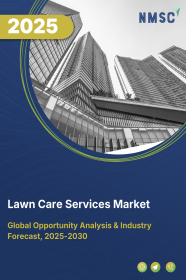
Lawn Care Services Market by Service Type (Lawn Maintenance, Landscaping, Pest Control, Irrigation Services, Fertilization Services, Aeration Services, Weed Control, and others), by Solutions (Soil Health, Plant Nutrition, and Pest Management), by Material Type (Biodegradable, Non-Biodegradable, and Recyclable), by Technology (Smart Irrigation, Robotic Mowers, and Soil Sensors), by Application (Residential, Sports & Recreation, and others) – Global Industry Trends and Forecast, 2025–2030
Industry Overview
The global Lawn Care Services Market size is valued at USD 101.24 Billion in 2024, and is projected to grow to USD 105.39 Billion by 2025. Additionally, the industry is expected to continue its growth trajectory, reaching USD 130.44 Billion by 2030, with a CAGR of 4.4% from 2025 to 2030.
The market is undergoing a dynamic transformation driven by technological innovation, sustainability trends, and digital accessibility. The adoption of AI, IoT, and GPS-based technologies is enabling precision treatments, reducing operational waste, and enhancing service efficiency.
Simultaneously, growing environmental awareness and stricter water-use regulations are fueling demand for sustainable solutions, including organic fertilizers and smart irrigation systems. Companies are capitalizing on this shift by offering eco-friendly service packages tailored to conscious consumers.
Moreover, the rapid expansion of online marketplaces is democratizing access to lawn care, allowing millions of homeowners to connect with providers through streamlined booking platforms. This digital shift also empowers small businesses to scale without major marketing investments, fundamentally altering competitive dynamics across regions. Together, these factors are accelerating the market’s evolution toward smarter, greener, and more accessible lawn care services.
Growing Adoption of Cutting-Edge Technologies in Lawn Care Drives the Market Growth
The integration of AI, IoT, and advanced sensor technologies is transforming traditional lawn care into a precision-driven service, which is significantly boosting the market growth. Companies such as TruGreen’s “Smart Lawn Measurement Tool” use AI mapping to calculate exact treatment needs—optimizing fertilizer and pesticide application while reducing waste and costs.
Meanwhile, leading equipment manufacturers are rolling out boundary-wire-free robotic mowers that create systematic mowing patterns via RTK-based GPS and AI vision (e.g., Bosch Indego and Husqvarna Automower EPOS series). For example, The Husqvarna Automower 580L EPOS was officially launched on October 17, 2024 as part of Husqvarna Group's, unveiling of four new robotic lawnmowers (Automower 580 EPOS, Automower 580L EPOS, Automower 560 EPOS and Automower 535 AWD EPOS) designed for professional green space management.
Also, Bosch Indego launched their recent product, Indego S+ 500 in 2021, enhancing smart features and connectivity. These innovations not only save labor but also enhance coverage consistency, driving faster service cycles and improving customer satisfaction.
Growing Market Demand for Sustainable and Eco-Friendly Solutions Boosts Industry Growth
Heightened environmental awareness, alongside increasingly stringent water‐use regulations, is driving both consumers and lawn-care providers to adopt greener practices, which in turn boost the lawn care services market growth. Eco-conscious alternatives such as organic fertilizers, biopesticides, and water-saving mulches—are gaining momentum, aligning with the rising interest in sustainable gardening.
For example, LawnStarter, now offers “green” lawn-care packages that integrate organic treatment plans and smart irrigation technologies, enabling precise water management and reduced chemical runoff—appealing directly to homeowners seeking sustainable, environmentally responsible landscaping. Their Eco-Friendly Lawn Care Services comprises of organic treatments, smart irrigation and eco-friendly practices.
Proliferation of Online Marketplaces and On-Demand Service Platforms Fuel Market Growth
Online platforms are revolutionizing lawn care by aggregating local providers and streamlining booking, payments, and reviews. In June 2024, LawnStarter, the largest U.S. lawn care network, expanded into 198 new markets and 440 cities, more than doubling its reach to over 2,572 cities and granting 16 million additional homeowners’ access to online booking. This marketplace model offers consumers on-demand convenience while enabling small providers to scale rapidly without heavy marketing costs thus fuelling the lawn care services market expansion.
Seasonal Demand Cycles Acts as a Restraint in Lawn Care Services Market Demand
Pronounced seasonality significantly restrains the global market, particularly in regions with temperate climates. Demand peaks during spring and summer when grass growth accelerates, but drops sharply in autumn and becomes nearly dormant in winter. This seasonal cycle results in inconsistent revenue streams and underutilized resources, making it difficult for companies to maintain full-time staff and stable cash flows year-round.
Many businesses struggle to balance equipment investments and labor management with the short window of high demand. Additionally, seasonal fluctuations create challenges in customer retention and service continuity, often requiring diversification into off-season services like snow removal or landscaping.
The Rise of AI enabled Lawn Care Solutions Presents a Future Growth Opportunity
The introduction of advanced robotic mowers including the ANTHBOT Genie is poised to transform the market. The ANTHBOT Genie, officially launched in March 2025, is a fully autonomous, AI-driven robotic mower that transforms traditional lawn care.
Equipped with GPS positioning, real time 4 camera vision, and RTK-enhanced GPS, Genie seamlessly maps lawns, recognizes over 1,000 obstacles (including toys and wildlife), and customizes mowing patterns based on soil health and live weather data.
With intelligent “N-shaped” route planning and automatic rain-pausing, it ensures optimal coverage without human oversight. Its ability to generate multi-zone maps, avoid slopes up to 45°, and update OTA makes it a smarter, safer, and more efficient tool for modern lawn management
Market Segmentation and Scope of the study
The market report is segmented based on services, solutions, material type, technology, application, and region. By Services, the market is segmented into Lawn Maintenance, Landscaping, Pest Control, Irrigation Services, and others. By Solutions, the market is classified into Soil Health, Plant Nutrition, and Pest Management. By Material Type, the market is categorized into Biodegradable, Non-Biodegradable, and Recyclable. By Technology, the market is divided into Smart Irrigation, Robotic Mowers, Drones, and Soil Sensors. By Application, the market is segmented into Residential, Commercial, Sports & Recreation, Municipal, and Others. Regional analysis covers key regions including North America, Europe, Asia-Pacific, and the Rest of the World (RoW), providing a detailed breakdown across each of the aforementioned segments.
Geographical Analysis
North America dominates the lawn care services market share owing to high consumer spending on home improvement and outdoor aesthetics. In the United States, a growing trend of "outdoor living" and backyard transformations is boosting demand for professional lawn care services.
Additionally, the rise of subscription-based and app-enabled lawn care platforms, such as TruGreen and LawnStarter, is simplifying service access and encouraging regular maintenance. In Canada, well-maintained green spaces are increasingly valued, especially in suburban areas, further driving market expansion.
Europe is witnessing steady growth in the market, driven by strong environmental awareness and sustainability-focused landscaping trends. Countries like Germany, France, and the UK are promoting eco-friendly lawn maintenance aligned with EU biodiversity and urban greening goals.
Moreover, rising residential construction and high-income households are creating a strong customer base for outsourced lawn care. Demand is also supported by the commercial real estate and hospitality sectors, especially in countries with robust tourism economies.
Moreover, the Asia-Pacific region is emerging as a promising market due to rapid urbanization and smart city initiatives. Countries like Australia and Japan have a high adoption of landscaping services for residential and public spaces. Rising disposable incomes and growing aspirations for Western-style lawns and gardens, particularly in urban India and China, are expanding the consumer base. Additionally, increased government investments in parks and recreational green zones support long-term growth in the region.
In Latin America, the Middle East, and Africa, the lawn care market is gaining traction due to the expansion of the tourism and hospitality sectors. Countries like the UAE and South Africa are investing in beautifying hotel premises, resorts, and golf courses to attract tourists. Additionally, urban planning in cities like Dubai and Riyadh includes green infrastructure mandates, creating new opportunities for professional landscaping and lawn care providers.
Strategic Analysis of Companies in the Global Industry
As the global lawn care services industry evolves, top players are embracing innovation, sustainability, and digital transformation to strengthen their market position and respond to shifting consumer expectations. Companies are increasingly focusing on eco-friendly practices, operational efficiency, and workforce empowerment to stay competitive in a fragmented yet fast-growing market.
Recent developments by leading firms such as BrightView, Davey Tree, and U.S. Lawns highlight this trend:
-
BrightView is taking big steps toward eco-friendly landscaping by switching to quieter, cleaner equipment. As part of its Earth Day 2023 efforts, the company introduced over 1,000 electric landscaping machines and more than 400 hybrid and electric vehicles. This move shows BrightView’s strong commitment to sustainability and meets the growing demand for low-noise, zero-emission lawn care services.
-
In 2023, the company, Davey Tree launched a biochar facility in East Dundee, Illinois, which converts wood waste into soil-enhancing biochar—reducing landfill use and creating a sustainable new revenue stream.
-
Also, the company is also investing in digital tools like SAP, Fiori, and SAP SuccessFactors to better support its widely distributed, green-collar workforce. With its strong expertise in arboriculture and focus on environmentally sensitive solutions, Davey Tree is reinforcing its competitive edge in the market.
-
Lastly, the company, U.S. Lawns, in July 2024, partnered with Landscape Management Network (LMN), integrating LMN’s advanced budgeting, estimating, time tracking and crew management software across their franchise network—boosting operational efficiency, communication, and client responsiveness.
Lawn Care Services Market Key Segments
By Services
-
Lawn Maintenance
-
Landscaping
-
Pest Control
-
Irrigation Services
-
Fertilization Services
-
Aeration Services
-
Seeding Services
-
Weed Control
By Solutions
-
Soil Health
-
Plant Nutrition
-
Pest Management
By Material Type
-
Biodegradable
-
Non-Biodegradable
-
Recyclable
By Technology
-
Smart Irrigation
-
Robotic Mowers
-
Drones
-
Soil Sensors
By Application
-
Residential
-
Commercial
-
Sports & Recreation
-
Municipal
-
Others
By Region
-
North America
-
The U.S.
-
Canada
-
Mexico
-
-
Europe
-
The UK
-
Germany
-
France
-
Italy
-
Spain
-
Denmark
-
Netherlands
-
Finland
-
Sweden
-
Norway
-
Russia
-
Rest of Europe
-
-
Asia-Pacific
-
China
-
Japan
-
India
-
South Korea
-
Australia
-
Indonesia
-
Singapore
-
Taiwan
-
Thailand
-
Rest of Asia-Pacific
-
-
RoW
-
Middle East
-
Africa
-
Latin America
-
Key Players
-
BrightView
-
TruGreen
-
The Davey Tree Expert Co.
-
Jim’s Mowing
-
Yellowstone Landscape
-
SavATree
-
Lawn Doctor
-
U.S. Lawns
-
The Grounds Guys
-
Crewcut Lawn Mowing
-
LawnSavers
-
NaturaLawn of America
-
Massey Services
-
Nutri-Lawn
-
Ruppert Landscape
REPORT SCOPE AND SEGMENTATION:
|
Parameters |
Details |
|
Market Size in 2025 |
USD 105.39 Billion |
|
Revenue Forecast in 2030 |
USD 130.44 Billion |
|
Growth Rate |
CAGR of 4.4% from 2025 to 2030 |
|
Analysis Period |
2024–2030 |
|
Base Year Considered |
2024 |
|
Forecast Period |
2025–2030 |
|
Market Size Estimation |
Billion (USD) |
|
Growth Factors |
|
|
Countries Covered |
24 |
|
Companies Profiled |
20 |
|
Market Share |
Available for 10 companies |
|
Customization Scope |
Free customization (equivalent to up to 80 working hours of analysts) after purchase. Addition or alteration to country, regional, and segment scope. |
|
Pricing and Purchase Options |
Avail customized purchase options to meet your exact research needs. |

















 Speak to Our Analyst
Speak to Our Analyst
























